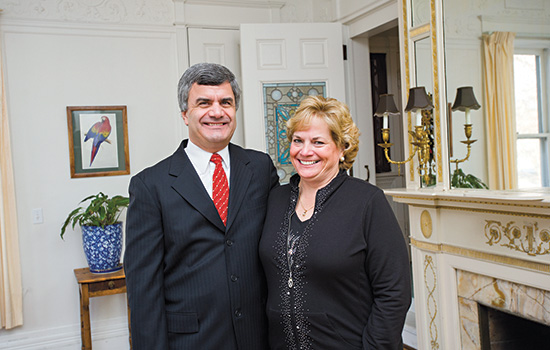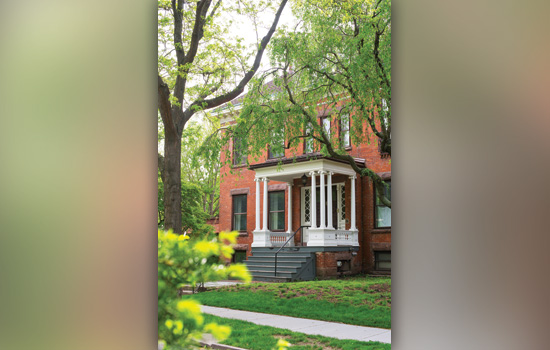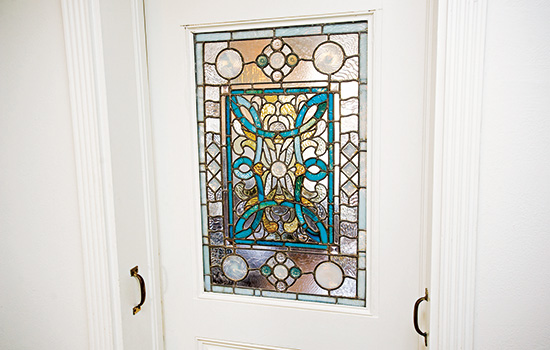Extreme makeover at 6 Sibley Place
A. Sue Weisler
A. Sue Weisler
Each year, Gerald McCue grabs some of the biggest 100-year-old peonies that are behind the mansion he owns at 6 Sibley Place and lays them near the stone of Emily Sibley Watson’s gravesite at Mt. Hope Cemetery.
“We have our own little conference where I say to her, ‘Emily, I’m back and I still have the house. I need your guidance with the renovations.’ ”
Built in 1860 before the Civil War began, the original 10,587-square-foot home was fashionably nestled on .42 acres in what would have been considered the extreme outskirts of Rochester. The owners were Elizabeth Atkinson Smith and her lawyer husband, Arthur, who sold it 10 years later to the richest man in Rochester—Hiram Sibley.
“Hiram bought 6 Sibley Place as a wedding present for his daughter, Emily, when she married her first husband (Isaac Averell) whom she later divorced,” explains McCue ’80 (MBA finance). “She then married James Sibley Watson, the son of her father’s longtime business partner at Western Union.
“Emily lived here only a short time and eventually moved to a home at 11 Prince St. that no longer stands.”
The Sibley ownership chain lasted 140 years and didn’t end until 2010, when McCue and his wife, Diane, a retired Kodak executive, purchased the mansion from the estate. McCue, who works as a first vice president of investments at Merrill Lynch, says a few people asked him if he knew what he was getting into.
“No, I told them,” he says, shaking his head. “This is the first house I have ever renovated. Diane and I felt it was an opportunity to bring back a property once owned by individuals who really took the risks and really made the difficult decisions that helped build Rochester.”
Back in its heyday, 6 Sibley Place was the forerunner of mansions along East Avenue—much more modest than the 35,000-square-foot home at 900 East Ave. built by George Eastman 60 years later. But it still had the distinguishing architectural characteristics, formal gardens and a carriage house that turned it into an urban manor designed for impressing upon visitors that those who resided there were powerful and affluent.
“These people had tremendous wealth and George Eastman visited frequently,” says McCue. “Emily was really the first generation of Sibley wealth that spent the majority of her life returning it to the community. She prized art and collecting and later bestowed a gift to the University of Rochester to establish the Memorial Art Gallery, which became a major cultural institution in Rochester.”
McCue says he grew up in a 1,300-square-foot ranch in Glens Falls, N.Y., and calls himself a country bumpkin who earned his undergraduate degree from the State University of New York at Potsdam. He came to Rochester to attend graduate school in 1978.
“As a graduate of RIT, none of our stories are as great as the RIT story and how the university has grown monumentally in the past 15 years,” McCue notes. “And from a Rochester history standpoint, there is a great story behind 6 Sibley Place.”
Although the McCues don’t live on the premises, the two-story mansion, complete with third-floor dormers where the servants used to live, has nine fireplaces and is now split into five apartments that are undergoing revolving renovation plans to restore the period-style “claw-foot” plumbing, oak floors, ornate ceilings, walls, moldings, doorways and windows.
McCue says he has relied on historical photos taken during parties at the mansion—when guests like Eastman and poet E.E. Cummings came to call—to figure out how the rooms are differently configured today.
The original facade has also been tampered with through the years, and the McCues—with Rochester Preservation Board approval—plan to remove additions such as the elevator shaft built in the 1940s, the garage, and a large, indoor pool and Jacuzzi dwelling behind the residence.
McCue says he knows what he wants every square inch to look like. He thinks it will take a decade to complete the renovation.
“I’m removing everything that is destroying the beauty of the property,” he says. “Three years ago you wouldn’t have seen the house. Landscapers removed chicken wire, barbed wire, wooden posts that were falling down, and layers of vegetation that accumulated in the backyard—but we saved the roses and the peonies. You can finally see the sunlight, and I hope Emily is looking out over her gardens in approval.”
 A. Sue Weisler
A. Sue Weisler
 A. Sue Weisler
A. Sue Weisler














